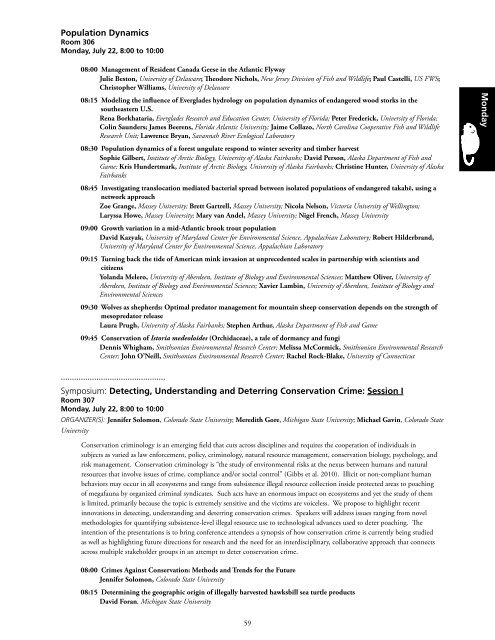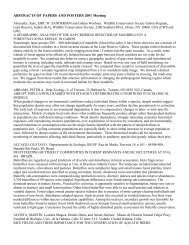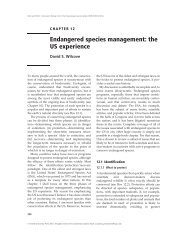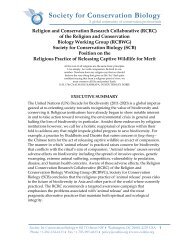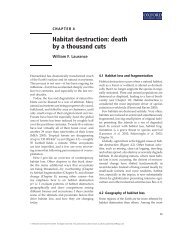ICCB 2013 Program - Society for Conservation Biology
ICCB 2013 Program - Society for Conservation Biology
ICCB 2013 Program - Society for Conservation Biology
You also want an ePaper? Increase the reach of your titles
YUMPU automatically turns print PDFs into web optimized ePapers that Google loves.
Population Dynamics<br />
Room 306<br />
Monday, July 22, 8:00 to 10:00<br />
08:00 Management of Resident Canada Geese in the Atlantic Flyway<br />
Julie Beston, University of Delaware; Theodore Nichols, New Jersey Division of Fish and Wildlife; Paul Castelli, US FWS;<br />
Christopher Williams, University of Delaware<br />
08:15 Modeling the influence of Everglades hydrology on population dynamics of endangered wood storks in the<br />
southeastern U.S.<br />
Rena Borkhataria, Everglades Research and Education Center, University of Florida; Peter Frederick, University of Florida;<br />
Colin Saunders; James Beerens, Florida Atlantic University; Jaime Collazo, North Carolina Cooperative Fish and Wildlife<br />
Research Unit; Lawrence Bryan, Savannah River Ecological Laboratory<br />
Monday<br />
08:30 Population dynamics of a <strong>for</strong>est ungulate respond to winter severity and timber harvest<br />
Sophie Gilbert, Institute of Arctic <strong>Biology</strong>, University of Alaska Fairbanks; David Person, Alaska Department of Fish and<br />
Game; Kris Hundertmark, Institute of Arctic <strong>Biology</strong>, University of Alaska Fairbanks; Christine Hunter, University of Alaska<br />
Fairbanks<br />
08:45 Investigating translocation mediated bacterial spread between isolated populations of endangered takahē, using a<br />
network approach<br />
Zoe Grange, Massey University; Brett Gartrell, Massey University; Nicola Nelson, Victoria University of Wellington;<br />
Laryssa Howe, Massey University; Mary van Andel, Massey University; Nigel French, Massey University<br />
09:00 Growth variation in a mid-Atlantic brook trout population<br />
David Kazyak, University of Maryland Center <strong>for</strong> Environmental Science, Appalachian Laboratory; Robert Hilderbrand,<br />
University of Maryland Center <strong>for</strong> Environmental Science, Appalachian Laboratory<br />
09:15 Turning back the tide of American mink invasion at unprecedented scales in partnership with scientists and<br />
citizens<br />
Yolanda Melero, University of Aberdeen, Institute of <strong>Biology</strong> and Environmental Sciences; Matthew Oliver, University of<br />
Aberdeen, Institute of <strong>Biology</strong> and Environmental Sciences; Xavier Lambin, University of Aberdeen, Institute of <strong>Biology</strong> and<br />
Environmental Sciences<br />
09:30 Wolves as shepherds: Optimal predator management <strong>for</strong> mountain sheep conservation depends on the strength of<br />
mesopredator release<br />
Laura Prugh, University of Alaska Fairbanks; Stephen Arthur, Alaska Department of Fish and Game<br />
09:45 <strong>Conservation</strong> of Istoria medeoloides (Orchidaceae), a tale of dormancy and fungi<br />
Dennis Whigham, Smithsonian Environmental Research Center; Melissa McCormick, Smithsonian Environmental Research<br />
Center; John O’Neill, Smithsonian Environmental Research Center; Rachel Rock-Blake, University of Connecticut<br />
...............................................<br />
Symposium: Detecting, Understanding and Deterring <strong>Conservation</strong> Crime: Session I<br />
Room 307<br />
Monday, July 22, 8:00 to 10:00<br />
Organizer(s): Jennifer Solomon, Colorado State University; Meredith Gore, Michigan State University; Michael Gavin, Colorado State<br />
University<br />
<strong>Conservation</strong> criminology is an emerging field that cuts across disciplines and requires the cooperation of individuals in<br />
subjects as varied as law en<strong>for</strong>cement, policy, criminology, natural resource management, conservation biology, psychology, and<br />
risk management. <strong>Conservation</strong> criminology is “the study of environmental risks at the nexus between humans and natural<br />
resources that involve issues of crime, compliance and/or social control” (Gibbs et al. 2010). Illicit or non-compliant human<br />
behaviors may occur in all ecosystems and range from subsistence illegal resource collection inside protected areas to poaching<br />
of megafauna by organized criminal syndicates. Such acts have an enormous impact on ecosystems and yet the study of them<br />
is limited, primarily because the topic is extremely sensitive and the victims are voiceless. We propose to highlight recent<br />
innovations in detecting, understanding and deterring conservation crimes. Speakers will address issues ranging from novel<br />
methodologies <strong>for</strong> quantifying subsistence-level illegal resource use to technological advances used to deter poaching. The<br />
intention of the presentations is to bring conference attendees a synopsis of how conservation crime is currently being studied<br />
as well as highlighting future directions <strong>for</strong> research and the need <strong>for</strong> an interdisciplinary, collaborative approach that connects<br />
across multiple stakeholder groups in an attempt to deter conservation crime.<br />
08:00 Crimes Against <strong>Conservation</strong>: Methods and Trends <strong>for</strong> the Future<br />
Jennifer Solomon, Colorado State University<br />
08:15 Determining the geographic origin of illegally harvested hawksbill sea turtle products<br />
David Foran, Michigan State University<br />
59


